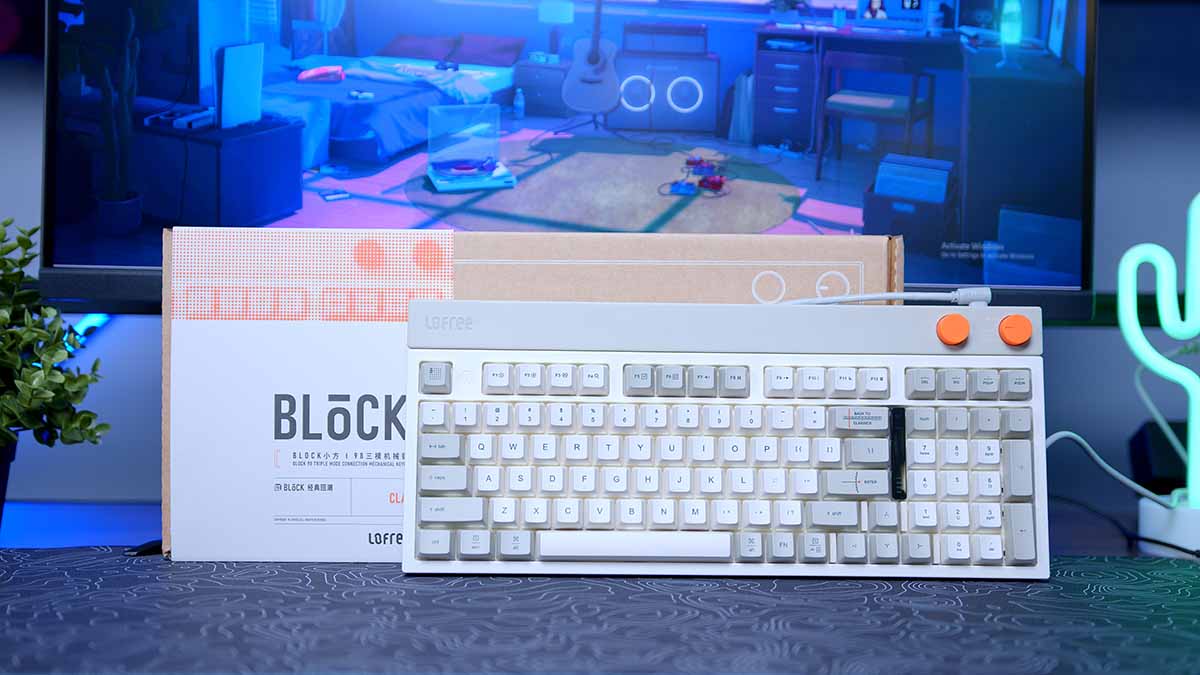Introduction
Mechanical keyboards have a long history that goes back to the 1980s, when personal computing started to gain popularity within domesticated spaces. We’ve seen the landscape significantly change over the years, with manufacturers offering up new designs that have less keys, and prioritise new features, such as RGB, silent switches, fancy colour schemes, customisability, and more.
But what if there was a keyboard that provides consumers with a retro-themed design, but is also packed with modern features? Meet the LoFree Block! A keyboard that takes you back to classics with a familiar beige colour scheme, whilst offering an excellent set of design elements geared towards the modern workstation user. We’ll be doing a deep dive on this keyboard, looking at the over-arching style, switches, keycaps, and feature-set.
Buy the LoFree Block on:
You can also get up to 10% off with the discount code ‘LF10’ when purchasing from the LoFree website.
Mechanical Keyboards – A Very Brief History
Mechanical keyboards have come a long way since their conception around the 1970s and 1980s. The first keyboard to popularise the use of mechanical switches was the IBM Model F, which arrived in 1981. This particular design utilised buckling-spring switches which were known for their loud and tactile feedback when fully pressed. Although these keyboards haven’t continued through to the modern age, a number of manufacturers and hobbyists are still keeping these age-old switches alive in modernised products, such as F104 Model F.

During the 1990s and early 2000s, mechanical keyboards took the backseat due to the rise of membrane options. These cheaper keyboards became a mainstay in the home computer market mainly due to their increased affordability. But towards the mid-2000s, mechanical keyboards saw a big resurgence due to PC gaming. A few small manufacturers began to produce new mechanical options that used modernised switches. Despite the high price that mechanical keyboards came in at, the wide range of switch types, keycap materials and customisation options were highly worth it for many.
And mechanical keyboards have continued to grow and evolve as we move into the modern age. Enthusiast-level customisation has become highly affordable, allowing consumers to change their switches and keycaps on the fly with minimal hassle. Higher quality materials are being used, to provide consumers with an unrivalled feel and experience, while customisability has become a major priority across all aspects and features of each product. Whether you’re a gamer looking to get the next Victory Royale, or you’re a consumer that works from home or in an office environment, it is highly likely there’s a mechanical keyboard on the market just for you!
Suggested Article: Surefire Harrier 360 Gaming Headset Review – Very Affordable Audio!
LoFree Block Design & Aesthetic
The reason why I thought it was prudent to talk about the history of mechanical keyboards, is because the LoFree Block is a ‘blast from the past’ so to speak. The first thing that you’ll notice about the design of the Block is that it sports a familiar beige style, which can easily be compared with some of IBM’s classic keyboards, such as the Model M and Model F. The Block sports a rectangular chassis with rounded edges. The chassis itself is quite hefty, weighing in at 1090g in total. For this reason, we probably wouldn’t recommend using the Block as a portable keyboard, this particular model is geared towards home setups.
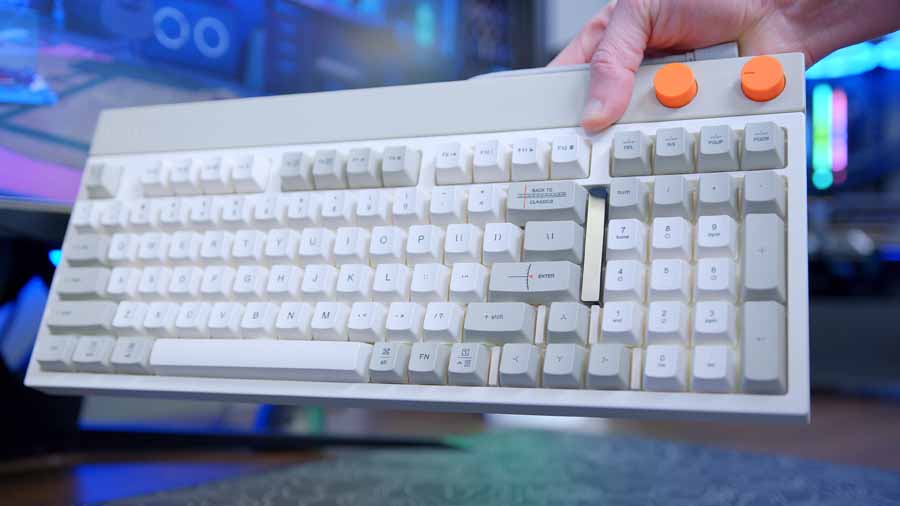
Taking a look at the colour scheme of the LoFree Block, I can only describe the design as beige. If you’ve ever used an older IBM keyboard, the keycaps have contrasting colours, and we’re seeing this reappear on the block. The vast majority of the keys on the Block are an off-white colour, while the rest of the keycaps are a grey-green tone. I personally quite like the contrast, I have a feeling of nostalgia using and looking at this keyboard, but I can fully understand consumers wanting to swap out the keycaps.
One of the main selling points of this keyboard is the retro design, so it does seem a bit pointless to me for the keycaps to be changed out for alternative ones. But if you’re not a fan of the look, the keycaps are hotswappable.

Towards the top right of the Block, consumers will find some orange knobs. These two knobs provide some extra functionality to the design of the Block. While I do like the colour scheme on this keyboard, the additional orange does brighten things up a bit. Flipping the keyboard over, you’ll also find some orange kickstands as well, which have two levels of adjustability, providing you with a way to get the Block at the right angle. Otherwise, there’s not much else to be said about the design. I do like the beige colour scheme, but I can fully understand that the retro theme may be a turn off for many.
LoFree Block Keycaps and Switches
The keycaps and switches of the LoFree Block are very important to the overall aesthetic of this keyboard, but they also majorly contribute to how this keyboard feels. The Block uses Dye-Sub PBT keycaps (which we saw feature on the LoFree Flow). These keycaps are a staple of LoFree keyboards, providing a level of resilience and feel that is effectively unrivalled.
The LoFree Block keycaps also utilise an OEM profile, which means there is a deepened concave that pulls your finger to the centre of each key. I do like that these keycaps offer a smooth response too, but this could potentially be a problem for gamers who need that extra level of grip or grit when pressing their main keys of choice.

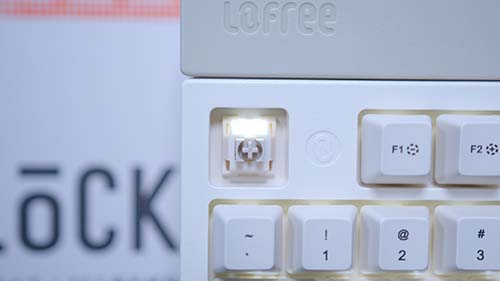
Moving onto the switches, the Block uses a customised TTC Full-POM Switch. As we touched on in our LoFree Flow review, POM material is self-lubricating, so usage over time makes your keyboard smoother when typing or gaming, which is a neat feature. The TTC switch is Linear in nature, so there’s no tactile feedback or click with each press. The TTC switches are not silent by any means, especially when we compare it to the likes of Corsair’s K70 Core.
However, the combination of the smooth housing and leaf-spring structure means that actuation is both fast, and somewhat muted, resulting in a more pleasant noise with each press. The switches on the LoFree Block have been curated to match the colour and aesthetic of the keycaps and chassis, which provides a well-rounded look to the design. It is worth noting that the Block is fully hot-swappable too, using a 5-pin cherry-style PCB.
In terms of feel, the LoFree Block is a very smooth keyboard. The actuation of the TTC switches is fast, making them ideal for speedy typists, or gamers prioritising responsiveness. Admittedly, the LoFree Block is louder than I’d like it to be.
Features We Like
In this section, we’ll be taking a look at the features that we like and don’t like. The LoFree Block is a very feature-rich design that caters to a range of different consumers, so we’ll be doing a deep dive on all of the important qualities of this keyboard.
Orange Control Knobs
As we’ve detailed in the design section, you’ll find two orange knobs towards the top right of the keyboard. Not only do these knobs add some extra flair to this keyboard, but they offer some extra functionality too. The left knob acts as volume control, with 360 degrees of rotation and a press for mute and unmute. The right knob allows you to switch between connectivity.
I like the addition of the orange knobs, as it allows users to easily change settings on the fly. Whether you’re muting your Spotify, or switching over to Bluetooth, this is very easily done.

Tri-Mode Connectivity
The Block offers consumers three different types of connectivity straight out of the box. You can utilise the included detachable USB-C cable, and switch the orange knob to cabled mode. For those that prefer a wireless setup, users can choose between either 2.4GHz or Bluetooth. The 2.4GHz dongle is located towards the back left of the keyboard, and Bluetooth can easily be setup within Windows or Mac settings.
There isn’t a whole lot to talk about in terms of connectivity, but this provides users with some options for their setup. It’s nice to see wireless connection modes appear on a retro-themed keyboard. It is worth noting that to change between 2.4GHz and Bluetooth, you’ll need to long press the ‘Fn’ and ‘4’ keys, but this changes the wireless mode quite quickly.
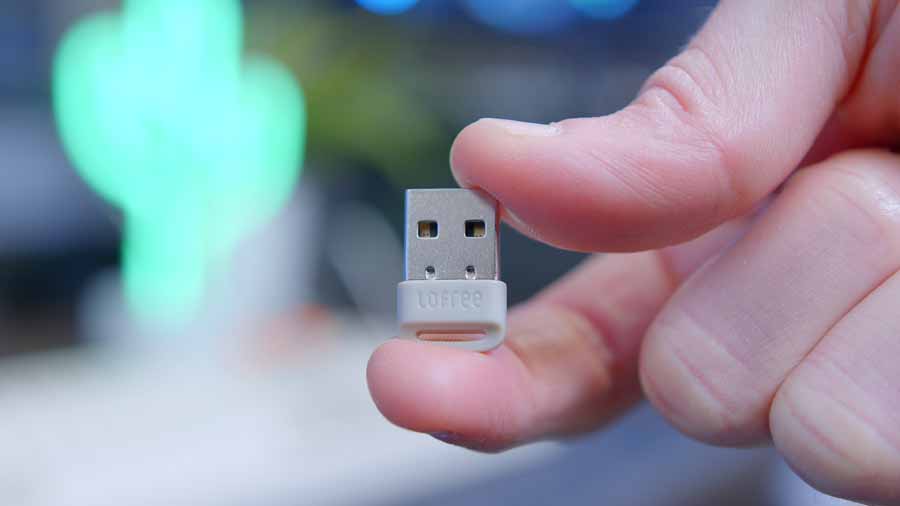
14 Backlighting Effects
The LoFree Block features white backlighting across all of the switches. This does provide some additional flair, especially if you’re gaming in the dark. One of the big caveats of the LoFree Flow is the fact that the lighting effects aren’t customisable, aside from the brightness. However, its nice to see that the Block allows you to change the effects on the fly. By holding down ‘Fn’ and pressing the arrow keys, you can adjust brightness and effects. There are 14 different backlighting modes to choose from, along with four levels of brightness.

Status Panel
Located between the numpad and main set of keys is a small status panel. This panel indicates whether Numlock or Caps Lock are on, along with how many devices are connected through Bluetooth and the battery life of the Block. This is a cool way of showing the keyboard status, and provides some additional flair to your setup.
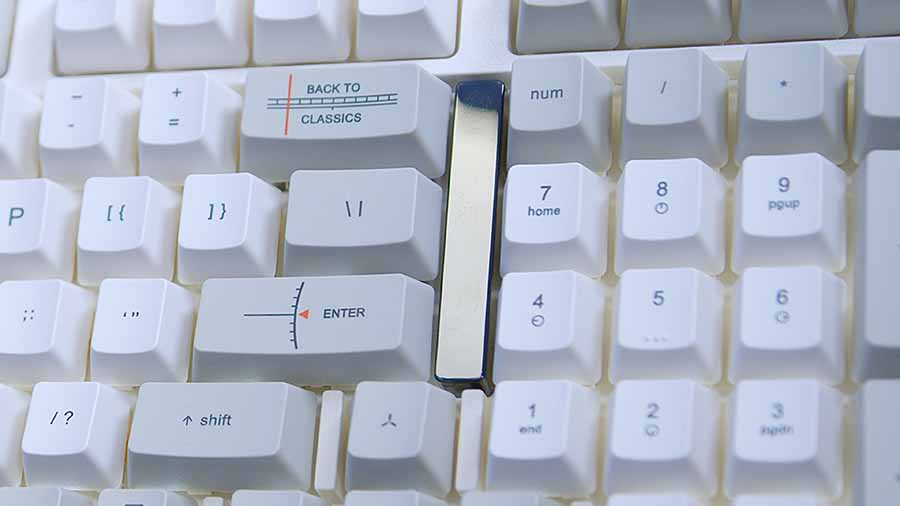
Features We Don’t Like
Lower Kickstand Height is Flimsy
The included kickstand allows consumers to adjust the LoFree Block to their desired height very easily. However, the first level of adjustability isn’t particularly strong. I’ve found that pushing too heavily on certain keys causes the stands to fall. I do feel more effort could have been put into the kickstands to provide consumers with better ergonomics.

Doesn’t Come With a Wrist Rest
I feel that keyboards with a focus on the typing experience need to have a wrist rest. A good wrist rest will minimise the amount of strain when typing, and it elevates the typing experience. Not only that, if a wrist rest were to come with the LoFree Block, I imagine it would also have a retro theme, further adding to the aesthetic of your setup. Its a shame to see that the Block doesn’t have a wrist rest, especially considering how much this keyboard is.

Conclusion
LoFree Block
Product Name: LoFree Block
Brand: LoFree
-
Features
-
Design
-
Versatility
-
Value For Money
Summary
LoFree’s Block is an awesome keyboard that brings the two most important aspects of any keyboard together (design and feel), unifying them completely. On the design front, users gain access to a retro-themed chassis that revives the two-tone grey and white keycaps we all know and love from original IBM Model F and Model M keyboards back in the 1980s. And in terms of feel, the Block is extremely smooth. From the initial press, all the way to actuation, the TTC Full-POM keycaps are really putting in the work here. LoFree have clearly put time into the typing and gaming experience that the Block keyboard provides, and this shows across all of their product SKUs that we’ve reviewed so far.
While I do feel an alternative like the F104 Model F will be a better option for the hardcore typists and enthusiasts, the price point of keyboards like the F104 won’t be appealing for many consumers. This makes the LoFree Block an excellent choice for users looking to pick up a strong keyboard that won’t cost them a small fortune.
My only major qualm that I have with the Block, is how loud it is. I feel the entire point of Linear keyboards, is to be quiet. If you want a loud keyboard, you’d get one with clicky switches. If you want responsive feedback without the noise, you’d pick up a keyboard with tactile switches. It makes little sense to me to go through the effort of making a switch incredibly smooth, and then ruin that with loads of extra noise. I do feel that the reason why this keyboard is a little bit louder is down to the design premise, which is to bring familiar retro keyboards into the modern world, so I’m not fully holding this against LoFree. But it would be great to see a similar retro-themed design that prioritises noise levels, instead of mimicking the noise capabilities of older keyboards. Noise levels aside, the LoFree Block is a nostalgic keyboard that I’d definitely recommend if you’re looking for a smooth option that lets you relive the past.
Pros
✅ Very smooth typing feel.
✅ Offers three connectivity modes.
✅ Retro theme looks awesome, especially with the contrasting orange.
Cons
❌ Quite loud considering this is a linear keyboard.
❌ Retro theme won’t be for everyone.
❌ Doesn’t come with a wrist rest.


